Entertainment
Hayao Miyazaki's Last Film & Why It Matters
I remember my first experience with a Hayao Miyazaki film very clearly: I had gathered with my college roommates to pick through our DVDs and find a movie to fill our cold February Saturday night. One person in the group suggested Spirited Away, but was quickly shouted down in favor of Princess of Mononoke, because we all needed to see Miyazaki’s “development as a filmmaker.”
Who is this man, I thought, and why does he warrant such high viewing standards?
As soon as I saw Princess Mononoke (and a few more of his films in the weeks after), I knew what every good film buff had known for years: Miyazaki is perhaps the best fantasy filmmaker of all time.
It comes as a shock, then, that his last film, The Wind Rises, does not create vast landscapes with both adorable and vicious creatures, but recounts the creation of the Mitsubishi Zero, the real-life plane Japan used in WWII. Many American commentators have asked why, at this political juncture in Miyazaki’s life, he has decided to depart from his native genre in favor of a movie which details the triumph of invention, without the aftermath of war.
While I don’t think I can fully answer this question, I do have a problem with the importance put on the “reality” of the plot of The Wind Rises by American reviewers. With the ongoing debates in many countries (including the U.S., lest we forget Japanese internment camps) about accurately remembering WWII, the line between fiction and history is often blurred for political and personal reasons. Also, the style of the trailer seems more Miyazaki than documentary: clouds drift across the screen as soothing music plays, making the entire sequence feel like a dream. And a good Miyazaki movie is just that — a dream.
So, as Americans wait to see the film that premieres Feb. 21, let’s all think about its historical implications. But more importantly, let’s see it as what it is: the swansong of one of the greatest dream-weavers of all time.
